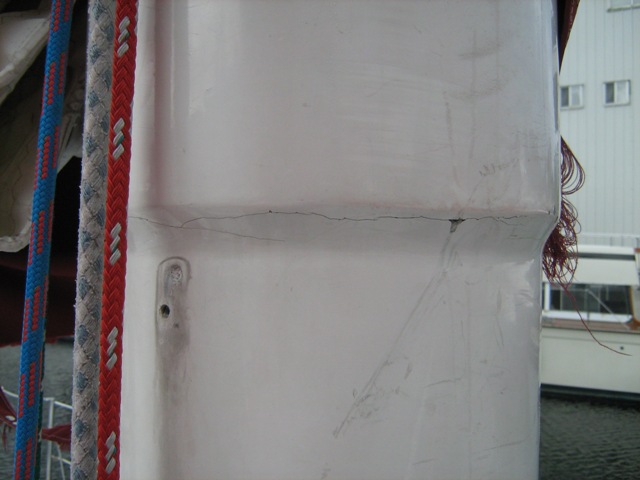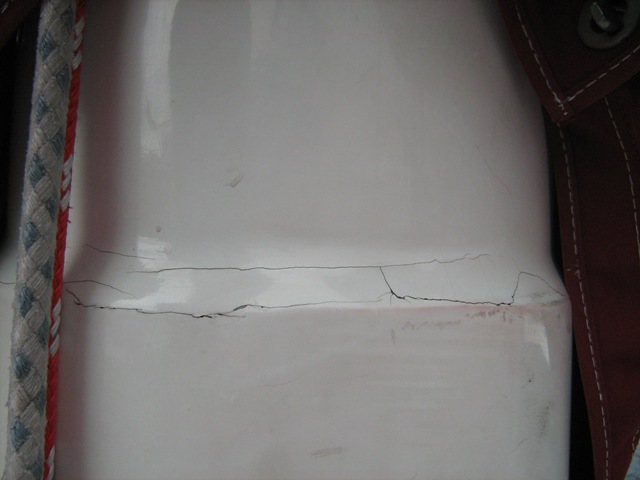That is correct the carbon runs verticle after which they layed up tape which was unidriectional. Since all fibers wrap in same direction after yrs of sun damage and stress, not to mention painting it BLACK, cracks started to appear on most all these masts. Talking to carbon fiber product builders they say that as the product increases in temp toward the cure temp the product weakens. I painted mine a light seafoam green color. They are cool to the touch even in fl summer sun. Numbknots
Those look like the typical surface cracks found on many Freedom masts. The early Freedom masts( perhaps all of them for all I know) were built with a fiberglass outer wrapping over the carbon fiber inner mast . This resulted in these cracks which is merely cosmetic from everything that I have read or heard. As previously mentioned there is a thread posted somewhere which goes into this in more detail, but I don’t think you have anything to worry about. I also have them on my masts , although I am lucky in that mine are not very noticeable and are very shallow and fine and not nearly as numerous…yet !! ![]()
![]()
Lots of useful reply’s have shown up here.
It sounds like my best course of action is a light sanding followed by a coat of light colored paint to keep the mast from acting like a frying pan in the summer - and then forget about it.
Thanks.
Abso F ing lutley Not! Do not just give a light sanding. That will not get, it I can promise you. I tried that approach and I had my face severely rubbed in it. Do nothing or do it right. There is no easy way. There are no short cuts. Suck it up, do it right the first time its the only short cut. Numbknots
Hey Philip,
I am the engineer that did the structural engineering on Freedom masts from 1980 - 85. I would not worry about the crack you are seeing. The laminate that creates the buldge below your crack is different from that which comprises the main body of the mast laminate. Most of the fiber in the mast runs straight up and down (some plus/minus 45 glass plies). The laminate in the collar runs 0/90 and is comrised of woven glass fiber. The dissimilar expansion and contraction of the glass and carbon fiber laminate will ultimately yield that type of crack. There is fairing material that forms the transition between the collar laminate and the mast laminate. Your crack is probably only in the fairing material wich is rigid and homogeneous (not unline polyester body filler). The constantly high torsional forces on the collar laminate as well as the expansion contraction are what cuased the crack. You might explore the crack to see if it is in the fairing material. If it is, this can be carefully sanded out (dremel tool) and replaced with a white flexible caulk (white GE silicone) and should not return.
Rick
Good day Rick,
Your response is encouraging. I my self am looking at one Freedom 36 built in 1986 and only issue I could note with the mast are the cracks that run around the entire circumferrence of that reinforcement doubler where gooseneck is for boom attachment.
Here are the the photographs I have taken yesterday. It seems the same issue as original poster has made.


I just purchased a 1980 freedom 28 CK, it has horrizontal cracks as described. I would be interested in hearing how to recover the mast with a fiberglass sock? Thanks. Art
My wife and I did it and wrote up all the details and stuck the file on our website at: http://www.mepsnbarry.com/pix/Mast-Refinishing.pdf
The writeup went thru the first coat of primer, and since then, I hired the fiberglass/painting expert in this boatyard to spray them with Sky Blue Awlgrip, and am happy with how they look. If I had it to do all over again (heaven forbid!) and wanted to be a perfectionist, I would probably have done a bit more fairing after the sock was glassed on, probably starting with a high-build primer. As I said in the file, I am sure I would have kept painting the masts with epoxy 'till all the weave was filled and hopefully not had any of the pinholes I was fighting through the next phases of the project.
And let me concur with somebody else: There’s no point doing a half-way job of painting over cracks like this. And doing this right is a BIG job.
Good writeup! I’m sure that your advise will be welcomed by anyone who undertakes (or this thinking about undertaking) this job.
– Geoff
Nicely done! When I rewrapped mine I wetted the masts first then pulled the sock over trying to make sure I had not dry spots. Now that was messy. My question is how in gods name did you manage to photograph all that work without ruining that camera? Now that showed some real skill. Numbknots
Great write-up I am saving the mast repairs on my Freedom 28 until I finish replacing the wet balsa core on my decks. Thanks for your input; it will help me plan my project both in terms of time and processes.
Err…the pix taken DURING a layup were taken by somebody else’s wife who was in the boatyard and happy to not watch her husband work for a change! She even took some video too. I figure I probably have got epoxy on my camera anyhow–Digicams are at least semi-disposable items!